Vol. 11 No. 2
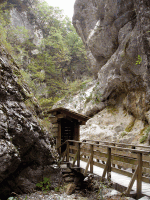 Gravely wounded, World War II Slovenia armed forces, U.S. pilots, and soldiers of other nationalities were carried blindfolded through the rushing waters of the barely accessible and narrow Pasice gorge. Hidden at the summit, was a simple hospital. A facility that saved more than 500 lives between 1943 and 1945.
Gravely wounded, World War II Slovenia armed forces, U.S. pilots, and soldiers of other nationalities were carried blindfolded through the rushing waters of the barely accessible and narrow Pasice gorge. Hidden at the summit, was a simple hospital. A facility that saved more than 500 lives between 1943 and 1945.
The hospital primarily treated soldiers from the 9th Corps of the Slovene Partisan Army engaged in warfare with the Nazi German Army in the Primorsko and Gorenjska region. After suffering severe causalities in the field, the idea of building a hidden partisan hospital to care for these dying men began to take root.
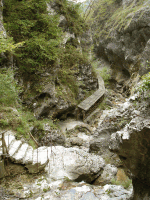 Janez Peternelj, a local resident of Cerkno, proposed the location for a clandestine partisan hospital to Dr. Viktor Volcjak. Its first cabin was built high in the almost inaccessible Pasice gorge, and on 23 December, 1943, the first wounded soldiers began arriving.
Janez Peternelj, a local resident of Cerkno, proposed the location for a clandestine partisan hospital to Dr. Viktor Volcjak. Its first cabin was built high in the almost inaccessible Pasice gorge, and on 23 December, 1943, the first wounded soldiers began arriving.
Between 1943 to 1945, Dr. Franja Bojc Bidovec, ran the lifesaving facility, one that has maintained and preserved its authentic appearance as a symbol of the partisan medical service. It is an emotionally moving testimony to the humanity and resourcefulness of partisan physicians, and the other medical staff in saving human lives.
 The hospital had the capacity to care for 120 patients at one time. 522 of the 1000 wounded soldiers were severely wounded. Soldiers carried to the hospital included Slovenes, citizens of Yugoslav nations, Italians, Frenchmen, Russian, Poles, Americans and an Austrian. A captured German soldier joined the hospital staff after his recovery remaining there until the end of the war.
The hospital had the capacity to care for 120 patients at one time. 522 of the 1000 wounded soldiers were severely wounded. Soldiers carried to the hospital included Slovenes, citizens of Yugoslav nations, Italians, Frenchmen, Russian, Poles, Americans and an Austrian. A captured German soldier joined the hospital staff after his recovery remaining there until the end of the war.
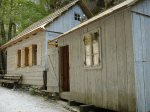 Sixty one patients died during the hospital’s two year operation. They were buried in unmarked graves along a trail above the hospital. A small bottle with personal identification and information was enclosed in their graves.
Sixty one patients died during the hospital’s two year operation. They were buried in unmarked graves along a trail above the hospital. A small bottle with personal identification and information was enclosed in their graves.
Admitted near a checkpoint near Pasice village, the wounded were blindfolded before being carried into the gorge. This was done as a measure of secrecy. If they were ever captured by the Germans, they would be unable to identify the location of the hospital. To hide the trail, the wounded were carried through the streambed in handmade stretchers. For their safety, bunkers and hidden shelters were built on steep rocky slopes.
 Despite operating in such a challenging terrain, and the frequent need to perform delicate surgical operations, most of the wounded were treated successfully. Hospital workshops made orthopedic accessories like casts and crutches. A new method was developed for sterilizing instruments and dressings. Other necessities of life were provided, and hospital patients never experienced hunger.
Despite operating in such a challenging terrain, and the frequent need to perform delicate surgical operations, most of the wounded were treated successfully. Hospital workshops made orthopedic accessories like casts and crutches. A new method was developed for sterilizing instruments and dressings. Other necessities of life were provided, and hospital patients never experienced hunger.
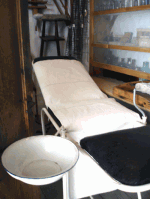 For Franja and the other clandestine partisan hospitals of Slovenia, conspiracy and security were crucial. If a hospital was discovered by the Germans, it lacked any effective ability to defend itself.
For Franja and the other clandestine partisan hospitals of Slovenia, conspiracy and security were crucial. If a hospital was discovered by the Germans, it lacked any effective ability to defend itself.
The success of the Franja Partisan hospital was attributed to the gushing stream flowing through the gorge. The trail of the wounded could not be traced. Those carried to the hospital by staff, were typically transported at night. Minefields and machine-gun nests were place in the surrounding area so that access to the hospital could only be made through the stream, footbridges and drawbridges hidden in the steep Pasice gorge.
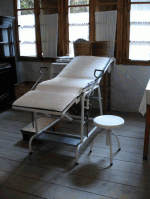 Still preserved in the steep walls rising above the stream are several fortified bunkers and natural caves, additional hiding places for the wounded. Although enemy forces launched several searches for the hospital, it was never discovered.
Still preserved in the steep walls rising above the stream are several fortified bunkers and natural caves, additional hiding places for the wounded. Although enemy forces launched several searches for the hospital, it was never discovered.
Today, small street signs direct visitors to the well-preserved hospital. A mile-long dirt path then a steel catwalk criss-crosses the gorge leading up to the thirteen wooden cabins. Some of the cabins include hospital wards, the orthopedic workshop, a surgical ward, doctors’ offices, a wood-burning stove kitchen, wards, and a simple office with a desk.
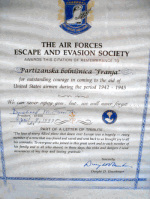 On it, lays a wrinkled letter, in a simple frame, from General Dwight D. Eisenhower. It is a thank you note to the Slovenians for saving the lives of American pilots shot down during the war.
On it, lays a wrinkled letter, in a simple frame, from General Dwight D. Eisenhower. It is a thank you note to the Slovenians for saving the lives of American pilots shot down during the war.
In spite of an enormous avalanche in January 1989, the hospital, its access buried and three cabins destroyed, was rebuilt and restored as a museum. More than 500 lives were saved by Dr. Franja. Devoted to her mission, she humbly declined any honors for her war heroism.
